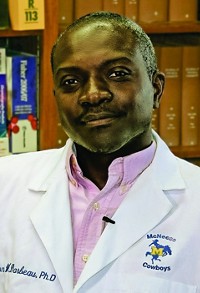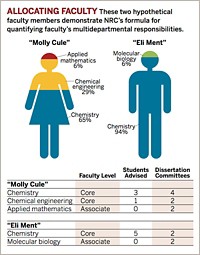Advertisement
Grab your lab coat. Let's get started
Welcome!
Welcome!
Create an account below to get 6 C&EN articles per month, receive newsletters and more - all free.
It seems this is your first time logging in online. Please enter the following information to continue.
As an ACS member you automatically get access to this site. All we need is few more details to create your reading experience.
Not you? Sign in with a different account.
Not you? Sign in with a different account.
ERROR 1
ERROR 1
ERROR 2
ERROR 2
ERROR 2
ERROR 2
ERROR 2
Password and Confirm password must match.
If you have an ACS member number, please enter it here so we can link this account to your membership. (optional)
ERROR 2
ACS values your privacy. By submitting your information, you are gaining access to C&EN and subscribing to our weekly newsletter. We use the information you provide to make your reading experience better, and we will never sell your data to third party members.
Education
Students Get A Say
Pioneering class helps undergraduate students explore their own scientific interests
by Celia Henry Arnaud
February 4, 2008
| A version of this story appeared in
Volume 86, Issue 5

Students can be drawn to chemistry for many reasons, and they can abandon the subject for just as many. If the material taught in their classes doesn't match their interests, they may not continue as chemistry majors. Although it can be hard in the standard chemistry curriculum to make that personal connection for every student, some institutions are determined to try.
A pilot class at the University of Illinois, Urbana-Champaign, called "The Chemistry and Biology of Everyday Life" (CBEL), gives students a voice in what they learn and engages them by focusing on their interests. The course was initially developed by chemistry professor Yi Lu and postdoc Brandy Russell, now an assistant professor at Gustavus Adolphus College in St. Peter, Minn. They hope that this class will encourage more students to continue as science majors.
The class works within the existing chemistry curriculum infrastructure. "We're a companion to the sequential curriculum," says Lauren A. Denofrio, a teaching laboratory specialist at Illinois and one of the current CBEL instructors. "We're helping the students enrich their experiences in those courses."
The course, which has been offered each spring for the past five years, mimics some of the activities of a research group. The students' interests are identified in a preenrollment survey and used to assign the students to groups. They participate in journal clubs, special topic discussions, and research assignments. They are allowed and even encouraged to take the course multiple times. The students receive the same type of credit that is awarded for undergraduate research and seminar courses.
Returning students mentor younger ones. This mentoring aspect is a key component of the program. Normally, "freshmen see only freshmen," Lu says. "They rarely see juniors or seniors who can help them." These peer mentors draw from their own experiences to advise the younger students about classes that will best meet their goals.
The class format varies by day of the week. On Mondays, Lu or an invited speaker lectures on a topic chosen on the basis of student interests. On Wednesdays, the students participate in a variety of activities such as special topic discussions and journal club presentations. The discussions have focused on issues such as drug safety, steroid use, and trans-fat bans. On Fridays, subgroups find their own meeting locations, where they prepare for "Jeopardy!"-style quizzes, go over strategies for discussion groups, and practice their journal club presentations. In addition, the students get the opportunity to visit industrial labs and attend a scientific conference, such as the Pittsburgh Conference.
The broad topics covered in the course do not vary significantly from year to year. "A favorite topic seems to be forensic science," Lu says. Other popular topics relate to pharmaceuticals and nutrition.
Although the topics may repeat, students find value in taking the course multiple times. Senior Carolyn Mead, a chemistry and molecular and cellular biology major, has taken the class four times. "I keep taking CBEL because I know that each time I will learn or experience something new, something I couldn't get from any other university class," she says.
Joseph P. Gerdt, a senior chemistry major, says he "decided to take the course three more times for the opportunities to hear about new research from guest speakers and on conference trips, to pass my knowledge on to younger students, and to present my own research to the class."
Research is an important part of the class. Younger students do literature research, while the older students make presentations about their own research.
When students are ready to start doing undergraduate research, the instructors can help them choose a research group that is a good fit. "The students are overwhelmed by so many groups," Lu says. "We help them find a group that matches their interests."
CBEL convinced Mead to get involved in undergraduate research. "Before taking CBEL, I hadn't considered undergraduate research—I didn't even know it was an option for me. Now, I've been working in a chemistry lab for two years," she says. She works in Lu's lab, where she develops DNA-based sensors for drinking water contaminants. "Becoming involved in research completely changed my education. I'm sure I wouldn't be going to graduate school next year if I hadn't done research as an undergraduate."
So far, CBEL has been able to accommodate only a small number of students. The resource-intensive nature of the course, in terms of instructor involvement, has led the instructors to cap enrollment at about 30 students per semester.
In collaboration with David Lopatto, a psychology professor at Grinnell College, in Iowa, the instructors have assessed the short-term impact of the course using the Classroom Undergraduate Research Experience survey. The survey results indicate that the course participants "believe they have progressed in a number of areas valuable in scientific research," the developers write in a recent article about the class (Science 2007, 318, 1872).
The instructors are now introducing aspects of the program, particularly the journal clubs, discussion groups, and mentoring, to general chemistry classes. These activities have been implemented in two general chemistry classes of about 250 students each. Lu hopes that the larger number of students will provide the statistical data to assess the long-term impact of the program.




Join the conversation
Contact the reporter
Submit a Letter to the Editor for publication
Engage with us on Twitter